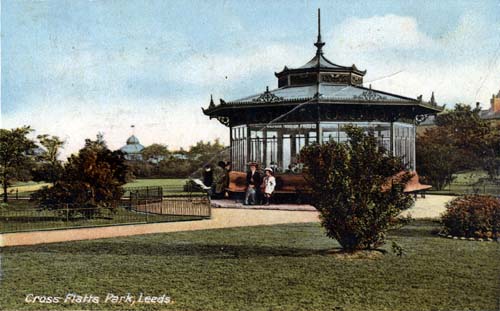Imagining tomorrow's urban green spaces
A team of researchers at the University of Leeds have been looking at the future role for UK public parks. In their recent publication ‘Park futures: Excavating images of tomorrow’s urban green spaces’ the team examine the historical role of parks, particularly in the Victorian era, to study the potential use and trends for parks into the future. Whilst British urban parks were key to the Victorian city, parks today are at a critical juncture in terms of their future purpose and sustainability.
Barker et al. (2020) position their work within a wider body of research that thinks about social futures by studying the past and present trends. The authors look not to extrapolate the future solely from the present but excavate seeds of the future in our knowledge of history.

Cross Flatts Park, c.1916. Artemis, Artforms, www.leodis.net
British urban parks were largely created in the 19th century and are central features of a modern city. Traditional views of parks, incorporating Victorian ideals and values, have long shaped the way in which public parks are developed and managed. The ideal park was once perceived to be a space that shaped social futures and provided an inclusive green space. However, UK parks have become increasingly threatened by conditions of funding and governance, leading to their declining condition and this has led to attempts to fund parks in new and different ways. Many feel that parks are quintessential public goods and threats to the future of parks present an issue around the accessibility of this public good.
In their recent paper, Barker et al. (2020) consider six images for future urban parks, based on different conditions of funding and governance, competing demands and park use. By looking to the past, the authors seek to produce images of tomorrow’s parks which represent different directions of travel for their management and use. The six images presented include club parks, theme parks, city magnet parks, variegated parks, co-mingling parks and for sale parks. Variations between the images demonstrate uncertainties around the contemporary purpose of parks and the role they play in society. The impact of the COVID-19 pandemic on these future images is considered in: ‘Parks in a Pandemic: A Glimpse into the Future?’
Whilst parks were integral to the 19th century view of an improving city, this vision is no longer so strong. Barker et al. point out that there is now a view that parks will serve different purposes and be managed differently. The study concludes that we are likely to see increasingly varied futures for urban parks, driven largely by the ways in which the managing authorities and the public respond to the pressures facing these green spaces (see video above). Barker et al. (2020) recognise the role that urban dwellers might play in shaping the future of parks, particularly where the pressures of urbanisation heighten demand for space. In their article discussing parks in the pandemic, Barker and Smith recognise ‘a new awareness of the importance of urban green spaces for wellbeing, particularly for citizens who do not have access to private gardens’. It is also recognised that Friends of Parks groups will likely play a greater role in the management and upkeep of local parks, including the required fundraising.
With divergent visions of how parks should look, the authors call for an informed public debate with a range of diverse civil society actors to capture a new overarching vision for parks in the 21st century: one that draws upon their rich heritage but remains unconstrained by it.
Read the full paper here: Barker, A., Crawford, A., Booth, N. and Churchill, D. 2020. Park futures: Excavating images of tomorrow’s urban green spaces. Urban Studies. 57(12), pp.2456-2472.
Dr Anna Barker has also written a ‘Think Piece’ on this topic, which can be accessed here.
